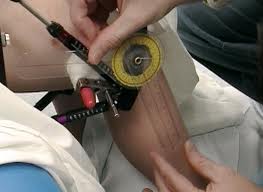Limb lengthening is distraction ostegenesis, also called callus distraction, a surgical process used for reconstruction of skeletal deformities, and for lengthening bones. Limb lengthening is a procedure in which a bone segment is surgically cut and a distraction device is used to slowly pull the two ends apart. After the desired limb extension has been achieved the bone consolidates until the lengthened gap has completely calcified.
The limb lengthening procedure works by gradually growing new bone and soft tissues (skin, muscle, nerves, blood vessels, etc). This new growth is called tissue regeneration. In this limb lengthening operation, bone and soft tissue regenerate when they are distracted (pulled apart) at a very slow rate of approximately 1 mm per day. If the rate of distraction is faster than this, bone may fail to form between the two ends of the bone that are being pulled apart and soft tissues, such as muscle, may experience contracture (get too tight) or nerves may become paralyzed. If the rate of distraction is too slow, premature consolidation may occur (the bone may consolidate too soon), preventing the lengthening device from further pulling it apart.
There are two phases of lengthening until the bone is fully healed: the distraction phase and the consolidation phase
The distraction phase: It is the lengthening phase. After the desired length is obtained, the newly regenerated bone is still very weak because of lack of calcium within it.
Consolidation phase: This occurs when the desired length has been reached and the bone begins to fully grow and harden. The uniqueness and value of distraction osteogenesis lies in its ability to simultaneously expand both the bone volume and the surrounding soft tissue.
Lengthening Devices Used
Limp Lengthening Device
A variety of orthopedic devices are used to distract the bone and soft tissues. The decision regarding which device to use is individualized for each case, so that the best method to achieve the desired correction can be chosen. There are two general types of devices: external fixators and internal fixators. The external devices attach to the bone from outside the body by means of wires and threaded pins. The internal devices are implanted inside the body and lie on the bone or inside the marrow cavity of the bone.
Kamalnayan Bajaj Hospital is one of the largest private hospitals in the state of Maharashtra and also a pioneering hospital in the field of Joint Replacement surgery in India. It is an extremely reputed multi-specialty hospital, renowned for its excellent medical expertise, nursing care and diagnostic services. Though it is a corporate hospital it is more of CSR (corporate social responsibilities and many of the surgeries are free). This hospital providing surgery for Limb Lengthening at low cost when compared with foreign countries.Limb lengthening is distraction ostegenesis, also called callus distraction, a surgical process used for reconstruction of skeletal deformities, and for lengthening bones. Limb lengthening is a procedure in which a bone segment is surgically cut and a distraction device is used to slowly pull the two ends apart. After the desired limb extension has been achieved the bone consolidates until the lengthened gap has completely calcified.
The limb lengthening procedure works by gradually growing new bone and soft tissues (skin, muscle, nerves, blood vessels, etc). This new growth is called tissue regeneration. In this limb lengthening operation, bone and soft tissue regenerate when they are distracted (pulled apart) at a very slow rate of approximately 1 mm per day. If the rate of distraction is faster than this, bone may fail to form between the two ends of the bone that are being pulled apart and soft tissues, such as muscle, may experience contracture (get too tight) or nerves may become paralyzed. If the rate of distraction is too slow, premature consolidation may occur (the bone may consolidate too soon), preventing the lengthening device from further pulling it apart.
There are two phases of lengthening until the bone is fully healed: the distraction phase and the consolidation phase
The distraction phase: It is the lengthening phase. After the desired length is obtained, the newly regenerated bone is still very weak because of lack of calcium within it.
Consolidation phase: This occurs when the desired length has been reached and the bone begins to fully grow and harden. The uniqueness and value of distraction osteogenesis lies in its ability to simultaneously expand both the bone volume and the surrounding soft tissue.
Limp Lengthening Device


A variety of orthopedic devices are usedtissues. The decision regarding which device to use is individualized for each case, so that the best method to achieve the desired correction can be chosen. There are two general types of devices: external fixators and internal fixators. The external devices attach to the bone from outside the body by means of wires and threaded pins. The internal devices are implanted inside the body and lie on the bone or inside the marrow cavity of the bone.




Comments should be on the topic and should not be abusive. The editorial team reserves the right to review and moderate the comments posted on the site.